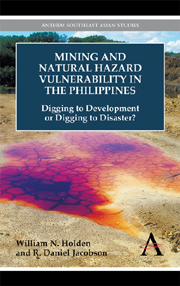 Mining and Natural Hazard Vulnerability in the Philippines
Mining and Natural Hazard Vulnerability in the Philippines Book contents
- Frontmatter
- Contents
- Acknowledgments
- List of Tables and Figures
- List of Acronyms
- Introduction
- Chapter One Mining in the Philippines
- Chapter Two Government Efforts to Encourage Mining
- Chapter Three Environmental Effects of Mining
- Chapter Four Mining amid Natural Hazards
- Chapter Five Technocratic Responses to the Risks
- Chapter Six Risk Society in the Philippines
- Chapter Seven Mining as a Flawed Development Paradigm
- Chapter Eight Is Another World Possible?
- Conclusion
- Bibliography
- Index
Chapter One - Mining in the Philippines
Published online by Cambridge University Press: 05 May 2012
- Frontmatter
- Contents
- Acknowledgments
- List of Tables and Figures
- List of Acronyms
- Introduction
- Chapter One Mining in the Philippines
- Chapter Two Government Efforts to Encourage Mining
- Chapter Three Environmental Effects of Mining
- Chapter Four Mining amid Natural Hazards
- Chapter Five Technocratic Responses to the Risks
- Chapter Six Risk Society in the Philippines
- Chapter Seven Mining as a Flawed Development Paradigm
- Chapter Eight Is Another World Possible?
- Conclusion
- Bibliography
- Index
Summary
The Philippines: A Developing Country in Southeast Asia
An introduction to the archipelago
The Republic of the Philippines is an archipelago of approximately 7,100 islands in Southeast Asia (Figure 1.1) located on the western side of the Pacific Ocean between latitude 20 degrees north and latitude 6 degrees south. The archipelago lies east of Vietnam, south of Taiwan and northeast of Borneo and consists of four distinct regions: the northern island of Luzon, the southern island of Mindanao, the long finger-like western island of Palawan and the central Visayan Islands. It has a land area of 300,000 square kilometers with approximately 65 percent of this being taken up by Luzon and Mindanao while only 500 of the 7,100 islands exceed one square kilometer in area (IBON 2002c). Located on the “Pacific Ring of Fire” – a belt of volcanoes running along the Pacific coasts of the Americas and Asia – the islands of the Philippines are mountainous and are frequently described as a series of “half drowned mountains” (IBON 2002c, 8). The majority of the land area of the archipelago consists of land over 350 meters above sea level with fl at land remaining concentrated in river valleys or in small discontinuous strips of coastal plains backed by steep mountains (Newson 1999). Indeed, the topography of the Philippines could be described as an outcrop of mountains emerging from the sea with a small fertile coastal strip and a series of narrow interior valleys (Bankoff 2003a).
- Type
- Chapter
- Information
- Mining and Natural Hazard Vulnerability in the PhilippinesDigging to Development or Digging to Disaster?, pp. 7 - 34Publisher: Anthem PressPrint publication year: 2012


